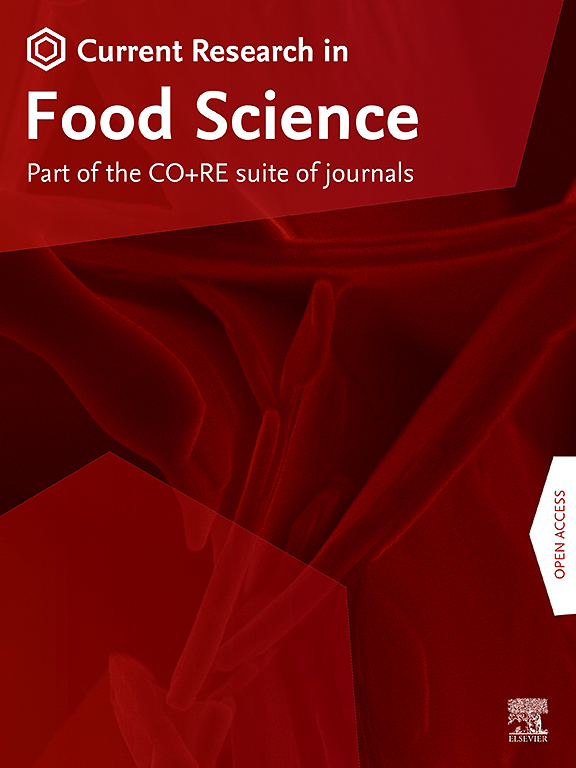Techno-functional of peanut flour substituting on hybrid chicken meatball physico-chemical and nutritional qualities
IF 7
2区 农林科学
Q1 FOOD SCIENCE & TECHNOLOGY
引用次数: 0
Abstract
Consumer demand for healthy and sustainable food has driven the development of alternative meat products. This study investigated the effects of substituting peanut flour for chicken meat in meat balls. The hybrid chicken meat balls (HCM) were prepared by replacing chicken breast with 0, 25, 50, and 75 % peanut flour. Proximate composition, physico-chemical properties, textural quality, and protein patterns of HCM were determined. The protein (18.15–20.78 %), fat (0.13-18.71%), fiber (0.56–1.82 %), and ash (1.53–2.32 %) content increased with an increase in peanut flour. The highest cooking yield (99.16 %) was observed at 75 % peanut flour HCM, resulting in the highest juiciness (14.92 %). Texture profile analysis suggested that sample 25 % peanut flour HCM exhibited the most promising textural attributes and higher flour contents resulted in a decline in most textural attributes. HCM with 25 % peanut flour displayed a dense and continuous protein network, whereas 50 and 75 % peanut flour HCM had a looser, more porous structure. The amino acid profile of 25 % peanut flour HCM showed a significant presence of essential amino acids. The study concludes that substituting 25 % peanut flour improves protein and fiber content while maintaining desirable textural attributes, suggesting that peanut flour is a promising and sustainable option for meat ball production.

花生粉替代对杂交鸡肉丸理化及营养品质的影响
消费者对健康和可持续食品的需求推动了替代肉类产品的发展。研究了用花生粉代替鸡肉制作肉丸的效果。用0、25%、50%和75%的花生粉代替鸡胸肉,制备了杂交鸡肉丸。测定了HCM的近似组成、物理化学性质、质地质量和蛋白质模式。蛋白质(18.15 ~ 20.78%)、脂肪(0.13 ~ 18.71%)、纤维(0.56 ~ 1.82%)、灰分(1.53 ~ 2.32%)含量随花生粉添加量的增加而增加。花生粉含量为75%时蒸煮得率最高(99.16%),多汁性最高(14.92%)。质构分析表明,25%花生粉HCM样品的质构属性最具潜力,高粉含量会导致大部分质构属性下降。添加25%花生粉的HCM具有致密且连续的蛋白质网络,而添加50%和75%花生粉的HCM具有更松散、更多孔的结构。25%花生粉HCM氨基酸谱显示必需氨基酸显著存在。该研究得出结论,替代25%的花生粉可以提高蛋白质和纤维含量,同时保持理想的质地特性,这表明花生粉是一种有前途的可持续选择。
本文章由计算机程序翻译,如有差异,请以英文原文为准。
求助全文
约1分钟内获得全文
求助全文
来源期刊

Current Research in Food Science
Agricultural and Biological Sciences-Food Science
CiteScore
7.40
自引率
3.20%
发文量
232
审稿时长
84 days
期刊介绍:
Current Research in Food Science is an international peer-reviewed journal dedicated to advancing the breadth of knowledge in the field of food science. It serves as a platform for publishing original research articles and short communications that encompass a wide array of topics, including food chemistry, physics, microbiology, nutrition, nutraceuticals, process and package engineering, materials science, food sustainability, and food security. By covering these diverse areas, the journal aims to provide a comprehensive source of the latest scientific findings and technological advancements that are shaping the future of the food industry. The journal's scope is designed to address the multidisciplinary nature of food science, reflecting its commitment to promoting innovation and ensuring the safety and quality of the food supply.
 求助内容:
求助内容: 应助结果提醒方式:
应助结果提醒方式:


